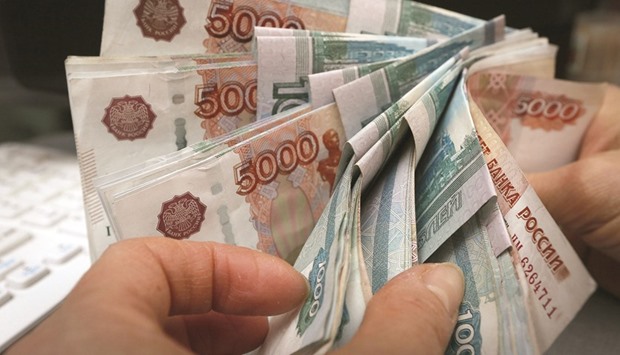The rouble’s world-beating gains may soon come to an abrupt end, according to the biggest foreign-exchange trader globally.
Citigroup says the odds are rising that the Bank of Russia starts buying dollars for the first time in almost a year if the rouble climbs to 60 against the greenback, compared with 67.822 on Monday, the strongest level this year. The currency will extend its appreciation into the low 60s, Citigroup said.
While an appreciating currency shows that Russia’s economy can weather international sanctions, too strong of a rouble might crimp budget revenue from oil and natural-gas export sales. Much of the gains have been driven by a rebound in oil, the nation’s biggest source of foreign earnings. The Bank of Russia’s signal last week that it’s in no hurry to cut interest rates is also propelling the currency’s increases.
“The rouble is a paper-oil currency and climbing crude, together with a dovish Fed-hawkish Bank of Russia combination, creates strong momentum,” said Denis Korshilov, head of fixed- income, currency and commodities at Citigroup’s Russian unit in Moscow. “The question mark here is if and when the central bank decides to start interventions to buy dollars.”
After posting the second-steepest drop for an emerging market currency in the last quarter of 2015, the rouble has bounced back from its weakest on record in January when crude sank to a 13-year low. It’s had the strongest gain worldwide in the past month, adding 11%. The rouble erased earlier gains on Tuesday, trading 0.4% weaker at 68.085 per dollar in Moscow, after explosions in Brussels caused deaths and injuries.
Almost half of Russia’s budget revenue comes from the oil and natural gas industries and price swings in global commodity markets have roiled the economy of the world’s biggest energy exporter and whipsawed the rouble.
Given that dependence, a weaker currency can help the government meet its budget target because more roubles are collected from each barrel of oil sold abroad. Brent in rouble terms was at 2,817 per barrel on Monday, about 10% below the level on which the 2016 budget is based, according to Bloomberg calculations. Oil traded near $41 on Tuesday as Opec said prices will rebound to a “moderate” level even if Iran doesn’t join other producers in freezing output.
“The central bank will likely use this opportunity to replenish reserves since the budget suffers from a stronger rouble,” said Oleg Popov, a money manager who oversees $300mn of assets at April Capital in Moscow. “I’d say they will definitely start buying FX if the ruble hits 60.”
Goldman Sachs Group and Danske Bank came out with more bullish forecasts for the currency last week. Goldman’s chief emerging markets macro strategist Kamakshya Trivedi has a “constructive view” on the Russian currency and predicts the rouble will reach 62 in 12 months, from 66 forecast earlier, while Danske has a forecast of 62.20.
The Bank of Russia last stepped into the foreign currency markets when the rouble strengthened below 50 against the dollar in May, purchasing dollars to replenish international reserves as sanctions over Ukraine and falling oil forced policy makers to burn through about $90bn in 2014 to slow the rouble’s drop. The Bank of Russia halted the purchases in July last year as the currency weakened toward 60 against the dollar.
“At these levels, I would be a seller,” said Dmitri Petrov, an analyst at Nomura International, whose 2015 rouble forecast was the most accurate according to a Bloomberg survey.

An employee counts rouble banknotes at a shop in Krasnoyarsk, Russia. After posting the second-steepest drop for an emerging market currency in the last quarter of 2015, the rouble has bounced back from its weakest on record in January when crude sank to a 13-year low.
